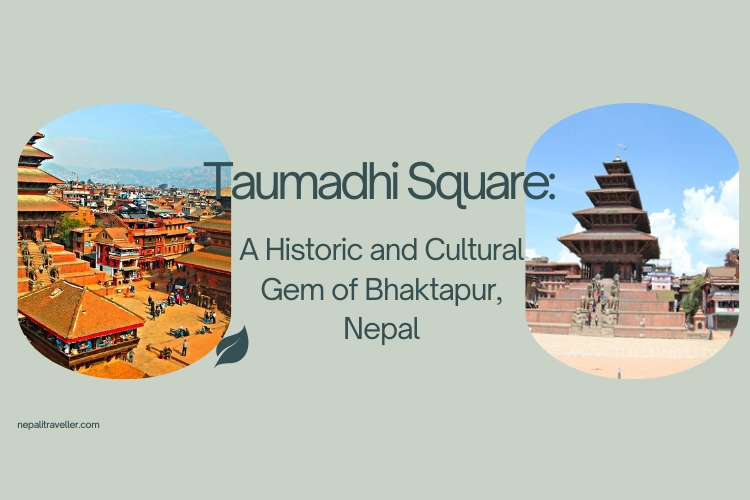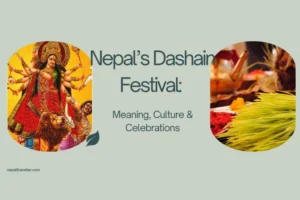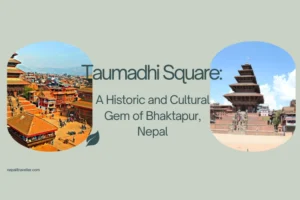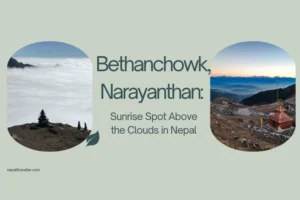Taumadhi Square is a historic square and vibrant public space in the heart of Bhaktapur, and represents both the architectural and cultural significance of this part of Nepal. As one of the main squares along the eastern side of the Bhaktapur Durbar Square, Taumadhi Square is a bustling, culturally rich place filled with important temples, markets, traditions, and deep-rooted practices attracting both locals and visitors. This blog will consider the history of Taumadhi Square, cultural significance, architectural significance, and the sheer magnitude of the experience in the square to prove that this is an essential destination to visit for anyone in Nepal.
Table of Contents
ToggleLocation and History
Taumadhi Square is located inside the medieval city of Bhaktapur, one of three royal cities in the Kathmandu Valley and as a UNESCO World Heritage Site. Bhaktapur has been settled since at least the 12th century and has been previously revered as the hub of Newar culture, traditional arts and architecture. Taumadhi Square is an important cultural center within this medieval city and is just an easy walk from the famous Bhaktapur Durbar Square.
“Taumadhi” is derived from the Newari expression “Ta: Maari” which means “big bread” and refers to the fact that the square was originally a large commercial hub and marketplace. Historically, this square has been the site of public festivals, a place for religious ritual, and a commercial center for local business. The importance of Taumadhi Square has stood the test of time, and it continues to be a place that incorporates the living traditions of Bhaktapur.
Architectural Highlights of Taumadhi Square
Nyatapola Temple: The Signature Temple
The symbol of the Taumadhi Square is Nyatapola Temple, built in 1702, during the reign of King Bhupatindra Malla. This temple is the tallest pagoda-style temple in Nepal at around 30 meters (108 feet) and among the tallest pagoda-style temples in the world. “Nyatapola”, means “five tiered”, a reference to the building’s five storeys which is a rarity in the Kathmandu Valley.
This temple is dedicated to Siddhi Lakshmi who is a potent tantric incarnation of Lakshmi, goddess of wealth. Although Nyatapola is tall, it has survived several serious earthquakes, including the 1934 Nepal-Bihar earthquake and the 2015 Gorkha earthquake, due to its elaborate wooden struts, square stone plinth, and craftsmanship.
Each tier of the wide plinth is crowned by pairs of stone sculptures representing power and guardianship:
- The lowest tier depicts the famous Newar wrestlers Jaimal and Pata.
- Above that are statues of elephants, lions, griffons, and finally the divine tiger and lion goddesses Baghini and Singhini.
The arrangement of these effigies represents successive levels of power and guardianship, showcasing the religious significance of the temple and the religious devotion of the city.
Bhairava Nath Temple
Just beside the Nyatapola is the historic temple to Bhairava Nath, or Bhairav, the fierce aspect of Lord Shiva, this Bhairava Temple is built of fine examples of traditional wood and stone craftsmanship. The Bhairava temple might appear smaller, but it is no less spiritually powerful than the tall pagoda.
Til Madhav Narayan Temple and Betal Temple
Another important religious structure is the Til Madhav Narayan Temple which still celebrates a traditional Newari ritual of approximately commensurate to belbivah (the sacred marriage) once a year, and the small Betal Temple directly next to Bhairava Temple. They all form important links in the sacred network of religious places established in the square helping to support the social and cultural rhythm of Bhaktapur.
Cultural Significance and Festivals
Taumadhi Square is not merely a heritage place, it continues to be a cultural space. It hosts some of the most important festivals of the city such as:
- Bisket Jatra: A lively and colorful Newari festival where local people gather around the square for chariot processions, traditional dance and rituals. During the Nepalese New Year, Taumadhi Square’s open spaces take on the energy of the festival as thousands of people come to celebrate.
- Gai Jatra: This cultural based festival is embedded in traditional performance arts as the square fills with stories and sustaining music culture to honor the dead.
- Newari Rituals: Rituals which are central to Newar religious practices are held regularly in the square, allowing continuity of medieval centuries old traditions.
The cultural identity of the square goes beyond festivals. Commercial space includes markets with artisans selling local crafts, souvenir shops and street vendors selling food such as bara, chatamari and other local dishes. Cafes and restaurants allow locals and tourists to experience Bhaktapur’s food culture.
Taumadhi Square Today: A Combination of Tradition and Modernity
Taumadhi Square maintains its authentic feel, even with the issues surrounding modernity. Actions have been made to promote low-impact traffic such as two-wheelers; cars are not allowed in this area due to crowding and the need to protect the peace for pedestrians. Visitors exploring the narrow streets and alleys which link themselves to Bhaktapur Durbar Square are often privy to street markets, artisan workshops, and the rhythm of life which is uniquely theirs. The traditional wooden windows with intricate carvings, red-bricked buildings with distinctive patterns, and the stone paving which can be walked and absorbed are altogether exquisite and timeless; they leave one feeling unchanged with this vision in recollection.
Efforts of sustainable tourism have developed in facilitating an acceptance of a delicate balance, one where preservation of heritage practice is done via the influx of visitors. Taumadhi Square and surrounding area has gained popularity via social media and travel blogs thus contributing to the decreased distance between a cultural gem and outsiders. That said, community value and identity through art, architecture, and festivals remains intact, and this evolving but unique site is taking small steps to maintain what is theirs. Boutique homestays and small heritage hotels are flourishing operations that allow visitors to get a terrific experience and contribute to the local social and economic life of the area while still respecting heritage principles.
Some Interesting Folklore and Facts
According to legend, the fierce god of Bhairava wreaked havoc in Bhaktapur until he was silked by a goddess Siddhi Lakshmi, who calmed him down and ceased the continual conflict, symbolized by the temple Nyatapola opposite of the temple of Bhairava god itself.
The temple doors of Nyatapola are unlocked for pilgrims only once every year, during a ceremony for a special anniversary in July – illustrating the virility of their sacred space.
Visiting Taumadhi Square: Tips for Travelers
- Best Time to Visit: The early morning and late afternoon hours provide beautiful soft light that is great for photography, and the opportunity to experience the life of the local community at its most vibrant.
- Guided Tours: If you are looking for stories and information behind the temples and rituals, consider hiring a local guide.
- Respect Local Customs: Some areas of the temples may be restricted for visitors and if there are signs posted and/or local customs observed, it is highly recommended to follow them, especially during worship, celebrations or festivals.
- Explore Nearby: Taumadhi Square offers a chance to visit many nice cultural discovery sites nearby including Bhaktapur Durbar Square and Pottery Square.
Conclusion
Taumadhi Square is a magnificent representation of the deep cultural heritage of Nepal, architectural creativity, and living traditions that continue to thrive in Bhaktapur. From the magnificently towering Nyatapola Temple, to the very small temples of Bhairava Nath and Til Madhav Narayan, Taumadhi Square, contains centuries of history in one place, that embodies day to day life in Bhaktapur. Taumadhi Square is also a living and breathing social and cultural hub where light and sound illuminates the pathways with festive celebrations, artisans keep their traditions alive, and visitors experience authentic Nepali heritage and culture. Anyone visiting the living ancient cities of Nepal needs to include this unforgettable experience to their traveling plans and tell people that they have been to Bhaktapur.







